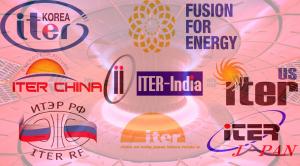ITER communicators brainstorm new approaches
10 Oct 2016
-
Laban Coblentz, Head of Communication
A central paradox for the ITER communicator is knowing that the ITER "product" is the largest, most complex multinational science and engineering project on Earth—arguably the largest in human history—and yet knowing also that a relatively tiny percentage of the global public has heard of ITER or tokamak fusion.
Last week communication specialists from the seven ITER Domestic Agencies came to ITER Headquarters for a two-day session to share their views, compare strategies, and explore new opportunities for collaboration.
Raising the ITER public profile, especially with the project in full-swing construction, is therefore a priority. Last week communication specialists from ITER's Domestic Agencies came to ITER Headquarters for a two-day session to share their views, compare strategies, and explore new opportunities for collaboration.
For both Domestic Agencies and the ITER central team, engagement in the effort to raise public awareness is enthusiastic and richly varied. In Russia, Alex Petrov carefully maintains a running dialogue with key journalists, ensuring they are consistently well-informed on ITER progress. The Indian Domestic Agency and its parent organization in Ahmedabad, the Institute for Plasma Research, sponsor a broad variety of outreach programs for students, ranging from year-long internships and summer education programs for secondary school children to a week-long program centred around National Science Day. The parent organization for the Korean Domestic Agency, the National Fusion Research Institute, has constructed a beautiful new Visitors Centre with polished displays on fusion, the KSTAR tokamak, and ITER.
Other initiatives focus on using technology, in simple or spectacular ways, to highlight features of the ITER Project. China has invested in an interactive tokamak model that draws large crowds at exhibits—including a visit from no less than President Xi Jinping earlier this year. Japan revealed an innovative new papercraft tokamak model, useful as a display or an educational tool. Europe proposed a standardized approach to communicating the percentage of completion for manufacturing contracts and other project aspects, using ITER-wide criteria and harmonized graphics. Lynne Degitz of the US ITER Project Office led a discussion on re-thinking the "value" of the ITER Project, articulating more consistently and broadly the acquired skills and ground-breaking technologies developed by ITER suppliers, as well as spin-offs that have non-fusion-related applications.
The COM group at the central ITER Organization demonstrated a new virtual tour under development, featuring 360-degree videos of the worksite shot with drones, and complete with an Oculus Rift for an immersive remote experience.
Broad discussions were also held comparing publications, photography and filming strategies, and communication budgets. A clear expectation was set for increased collaboration among the groups. The shared goal is clear: a continuous and significant expansion of public awareness of fusion and the ITER Project, with special attention directed toward key stakeholders and young audiences.


